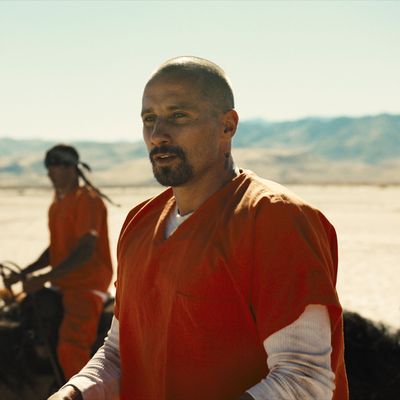
The phrase “I have to see a man about a horse” takes on new and inspirational meaning in The Mustang, the latest cinematic testament to the power of equine therapy. The protagonist is Roman Coleman (Matthias Schoenaerts), who has spent 12 years (and counting) at a maximum-security prison in Nevada for a crime he doesn’t speak of until late in the film, when he has begun to shed his defenses and soften. Until then, he’s so closed-down that the suspense is in whether he’ll answer a given question or make us wait 10 … 12 … 15 … seconds in vain. Fifteen silent seconds are a long time onscreen, and they’re pregnant. You can tell that Coleman is being eaten alive from within but have no sense of how he will or won’t act on his pain. Striking out is a distinct possibility and something he has in common with the wild mustang he’s tasked to ready for an upcoming auction, part of a program in which inmates learn to break — with a mixture of strength and gentleness — creatures not unlike themselves. In that horse, Coleman instantly recognizes his own mix of violence and vulnerability. And vice versa, doncha know.
On paper, The Mustang sounds like a Hallmark TV movie, and it’s true that it can’t quite shake off its aura of good mental hygiene. (Horse-whispering advocate Robert Redford signed on as an executive producer while the script was in development at his Sundance Institute.) But it has two mighty strengths. The first is the direction of Laure de Clermont-Tonnerre, which is muscular when it needs to be and otherwise plangent and meditative. The second is Schoenaerts, a major actor when his director knows enough to slow down and let his intensity work its spell — much as one would slow down to become attuned to a particular horse.
There’s a misperception that horses are great camera objects. They are in one way: No creature moves with such lyricism, from its rippling flanks to the arch of its long neck. But close-ups are tricky. Horses’ expressions don’t always read, and Clermont-Tonnerre has to resort to obviousness to show the swift rapport between Coleman and the mustang: a close-up of the horse’s eye, then a close-up of Coleman, whose face for the first time displays something other than dispiritedness. But Clermont-Tonnerre doesn’t go New Agey on us. Not long after that first glimmer of mutual empathy, the mustang lashes out at Coleman, who then pummels the creature’s flank with both fists and ends up on the ground beside the horse as inmates rush into the pen to break it up. It’s a sickening scene — it leaves you hating Coleman, even nodding along with Myles (Bruce Dern), the crusty old cuss in charge of the prison’s mustang program, when he tells the disgraced inmate, “I never want to see your Goddamned face again.”
Of course, if Myles doesn’t see Coleman’s Goddamned face again there’s no movie — and also no chance for Dern to show the heart under the crusty old cuss’s crusty old cussing exterior. And when Coleman is back in isolation, you can read his devastation in Schoenaerts’s shoulder tension, in how restless he suddenly is in his little cell, having felt a connection with something for the first time in years. The scenes in which Coleman goes back into the pen and begins to find a rhythm with the mustang (which he names “Marcus”) are slow to build, which is just how it should be — and how it is in the real-life horse-whisperer documentary Buck and in last year’s stirring The Rider. Jason Mitchell (he was Eazy-E in Straight Outta Compton) is marvelous as Henry, the self-proclaimed “best trainer in here” who tells Coleman, “Make him move around you … Respect his space and he’ll respect yours. I bet you don’t have one good dance move.” He’s right, Coleman doesn’t: Schoenaerts makes the prisoner uncomfortable in his own body, his closed posture a defense against both other prisoners and his own potential to act on his rage.
The Mustang flirts with formula and sometimes succumbs to it. The script (by Mona Fastvold, Brock Norman Brock, and Clermont-Tonnerre) introduces a villainous inmate who threatens the safety of Coleman’s daughter, Martha (Gideon Adlon), if Coleman doesn’t steal ketamine from the stash in the trainer’s office. (You’d think they’d keep the stuff more secure.) Parts of the climax and its aftermath go by too quickly. (Was the film trimmed for length?) But the plot machinations aren’t as important as Schoenaerts face, which finally opens to us. The second of his scenes with Adlon could have been played for pathos but Clermont-Tonnerre (and Adlon) resist. Coleman can finally bare himself, but it’s impossible for Martha to reciprocate. Her trust will take longer to win than the mustang’s.
What Clermont-Tonnerre and her cinematographer (Ruben Impens) and editor (Géraldine Mangenot) and sound designers nail is the heightened physicality of moving with — or just standing next to — a horse. I’ve been lucky enough to see equine therapy up close, and The Mustang brought the sensation back of having to slow down and breathe with a horse and in the process leave yourself behind. Any movie that makes leaving oneself behind so tactile and enticing is a horse of a different color.


